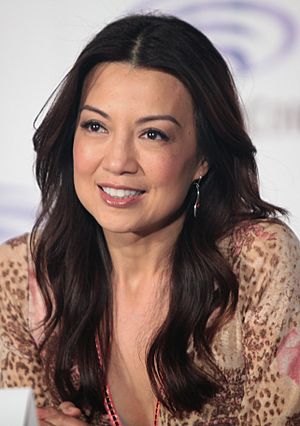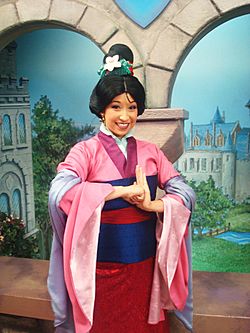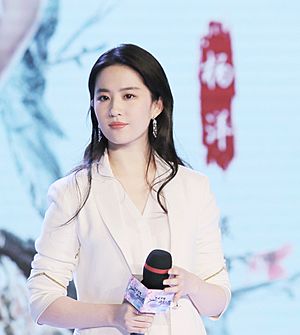Mulan (Disney character) facts for kids
Quick facts for kids Mulan |
|
|---|---|
| Mulan character | |

Mulan as she appears in Mulan (1998).
|
|
| First appearance | Mulan (1998) |
| Created by | Robert D. San Souci |
| Portrayed by | Yifei Liu (2020 film) Crystal Rao (child) (2020 film) |
| Voiced by | Ming-Na Wen (speaking voice) Lea Salonga (singing voice) |
| Based on | Hua Mulan from the Ballad of Hua Mulan |
| Information | |
| Aliases | Fa Ping (male alter ego) Hua Jun (male alter ego in 2020 film) |
| Occupation | Imperial agent Soldier Farm girl Warrior |
| Affiliation | Disney Princesses |
| Family | 1998 film: Fa Zhou (father) Fa Li (mother) Grandmother Fa (grandmother) First Ancestor Fa (ancestor) 2020 film: Hua Zhou (father) Hua Li (mother) Hua Xiu (sister) |
| Spouse(s) | Li Shang |
| Relatives | Fa Zhou (father) Fa Li (mother) Grandmother Fa (grandmother) General Li (father-in-law) |
| Nationality | Chinese |
Fa Mulan is a brave and famous character from Disney's 1998 animated movie, Mulan. She is based on a real Chinese legend about a warrior named Hua Mulan. In the story, Mulan is the only child of an older soldier. To protect her father, she secretly pretends to be a man and joins the army in his place.
Disney wanted Mulan to be a strong and independent hero. Her story shows that she doesn't need a prince to save her. She became the eighth Disney Princess, but she is unique because she isn't actually a princess by birth or marriage. She is also the first Disney Princess of Asian background. Ming-Na Wen provides Mulan's speaking voice, and Lea Salonga does her singing voice.
Creating the Character of Mulan
How Mulan's Story Began
The idea for Mulan started in 1994 as a short cartoon. It was about a Chinese girl who ran away to Europe. But then, author Robert D. San Souci found the Ballad of Mulan. This is an old Chinese poem about a woman named Hua Mulan. She takes her sick father's place in the army by pretending to be a man.
San Souci loved Hua Mulan's story and suggested it to Disney. He was then hired to write the movie's first story ideas. The movie explores the idea of being true to yourself. Co-director Tony Bancroft said Mulan's story is about a girl who is herself, even when society tells her to be someone else.
The filmmakers changed some parts of the old poem. For example, Mulan doesn't ask her parents for permission to join the army. Also, her last name was changed to "Fa" (Cantonese for Hua). In the movie, her secret is found out earlier than in the original legend.
Mulan's Voice Actors

The speaking voice for Mulan is provided by actress Ming-Na Wen. Director Tony Bancroft thought Wen had the "perfect" voice for Mulan. He said her voice sounded "very Chinese" and fit Mulan's traditional values. Wen grew up in Macau, China, and knew the legend of Hua Mulan very well. Her mother often read the poem to her.
This was Wen's first time doing voice acting. She enjoyed using her imagination, pretending to use a sword and ride a horse. Even though Mulan has many scenes with Mushu, the dragon voiced by Eddie Murphy, Wen and Murphy recorded their lines separately.
Lea Salonga, a singer and actress, provides Mulan's singing voice. She sings in songs like "Reflection" and "I'll Make a Man Out of You". Salonga had also sung for Princess Jasmine in Disney's Aladdin (1992).
Mulan's Character and Look
The writers wanted Mulan to be a new kind of Disney hero. They wanted her to be strong and brave, not a "damsel in distress". Director Tony Bancroft has daughters, and he wanted to create a hero who could be strong on her own. He wanted Mulan to be a good role model for girls.
Mulan is different from other Disney heroes. Most heroes get help from others to change. Mulan stays true to herself from beginning to end. Her personality and drive remain the same throughout the movie.
Artists were inspired by Chinese and Japanese art for Mulan's look. Her simple lines look like classic Asian paintings. Chinese artist Chen Yi helped the animators with these designs. Mark Henn was the main animator for Mulan.
Animating Mulan when she was disguised as a man, "Ping," was a challenge. Henn made her look a little different physically when she was Ping. Mulan was also designed to look less feminine than other Disney heroines. This was important so she could pass as a man in the army.
Henn was drawn to Mulan's unique and exciting story. He also animated Fa Zhou, Mulan's father. He called their relationship the "emotional heart of the story." Henn has a daughter himself, and he used his own feelings to animate their scenes.
Many people describe Mulan as a tomboy. She isn't interested in being a traditional wife. She is often clumsy and awkward. Her design shows broad shoulders and strong limbs. She often wears loose clothing. Mulan is also seen as very smart.
Mulan's Adventures in Films
The First Mulan Movie (1998)
The story begins when the Huns, led by Shan Yu, invade China. The Emperor orders one man from each family to join the army. Mulan's father, an old soldier, is called to fight. Mulan knows he is too weak. So, she secretly takes his armor and disguises herself as a boy named Ping. She joins the army in his place.
Mulan's ancestors send a small dragon named Mushu to help her. Mushu joins Mulan in the army. Mulan struggles at first, but she trains hard under Captain Li Shang. She and her friends, Yao, Ling, and Chien-Po, become good warriors.
The army is ambushed by the Huns. Mulan cleverly causes an avalanche with a cannon, burying most of the Huns. But she gets hurt, and her secret is revealed. Shang spares her life but expels her from the army.
Mulan then sees that Shan Yu and a few Huns survived. She rushes to the imperial city to warn Shang. The Huns capture the Emperor. Mulan, Shang, and her friends work together to save him. Mulan lures Shan Yu onto the roof and defeats him with Mushu's help.
The Emperor and the city praise Mulan. She is offered a position as an advisor, but she chooses to return home. Shang follows her, and they begin a romantic relationship. Mushu is also made a family guardian again.
Mulan II (2004)
In Mulan II, Mulan and Li Shang are about to get married. But the Emperor gives them a new task. They must escort his three daughters to marry princes in another land. Mulan and Shang have some disagreements during the trip.
Mushu worries that if Mulan marries Shang, she won't need him as her guardian anymore. So, he tries to break them up. During an attack, Shang is seemingly killed. To save the princesses from forced marriages, Mulan decides to take their place.
Shang survives and arrives in time to stop the wedding. Mushu, pretending to be a powerful dragon, frees the princesses from their vows. He then marries Mulan and Shang himself. Mulan forgives Mushu. Shang learns about Mushu and allows him to keep his guardian role.
Other Film Appearances
Mulan also made a cameo appearance with other Disney Princesses in the movie Ralph Breaks the Internet.
Live-action Mulan (2020)
Yifei Liu plays Mulan in the live-action movie from 2020. Her journey in this film is similar to the animated one. However, she has a sister in this version. Also, a phoenix acts as her guardian instead of Mushu.
Mulan in the Disney Princess World
Mulan is the eighth official member of the Disney Princess group. This is a special group for young girls. Mulan teaches kids to never give up and to be brave. She shows that gender roles don't limit what you can do. She also highlights the importance of family and honor.
On the official Disney Princess website, Mulan is described as "a loving girl who is always brave and bold." She uses courage and determination to win the day. Even though she's a Disney Princess, she wasn't born a princess and doesn't marry a prince. She is the first and only East Asian member of the group.
Mulan at Disney Parks and Shows

You can often meet Mulan at Walt Disney Parks and Resorts. She appears in parades and shows, especially at the Chinese Pavilion in Epcot. Mulan and Mushu also make small appearances in the "It's a Small World" ride at some parks. You can often find her with Li Shang and Mushu in Adventureland. There's also a picture of her with other Disney Princesses at the Princess Fairytale Hall in the Magic Kingdom.
On the Disney Cruise Line ships, Mulan and Li Shang are in the stage show The Golden Mickeys. Mulan also appears in Disney on Ice shows.
Mulan on Television
Mulan has made cameo appearances in the House of Mouse TV series. She was also in the direct-to-video movie Mickey's Magical Christmas: Snowed in at the House of Mouse.
In 2014, Ming-Na Wen and Lea Salonga returned to voice Mulan for the show Sofia the First. In an episode, Mulan sings a song called "Stronger Than They Know." Mulan was the seventh Disney Princess to appear on that show.
Mulan in Video Games
Mulan is a playable character in several video games. She appears in Disney's Story Studio: Mulan for PlayStation and Disney's Mulan for Game Boy.
She is also a playable character in Disney Infinity 3.0. You can unlock her for a limited time in Disney Magic Kingdoms.
Kingdom Hearts Series
Mulan appears in the video game Kingdom Hearts II. She helps the main character, Sora, in battles. She uses a sword called "Sword of the Ancestor." She goes by her male name, Ping, for most of Sora's first visit. Later, she fights alongside Sora against new enemies.
Mulan in Books
Reflection: A Twisted Tale
In the book Reflection: A Twisted Tale, the author Elizabeth Lim explores a different story. What if Mulan had to go to the Underworld? In this book, Shang dies, and Mulan journeys to the Chinese underworld to save his soul. The story uses many ideas from Chinese mythology.
See also
 In Spanish: Mulan (personaje de Disney) para niños
In Spanish: Mulan (personaje de Disney) para niños


